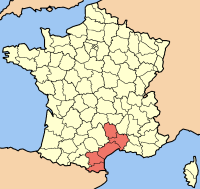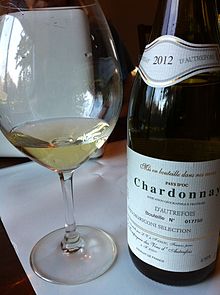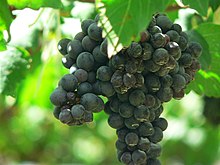Languedoc-Roussillon wine

Languedoc-Roussillon wine, including the
History

The history of Languedoc wines can be traced to the first vineyards planted along the coast near Narbonne by the early Greeks in the fifth century BC. Along with parts of Provence, these are the oldest planted vineyards in France. The region of Languedoc has belonged to France since the thirteenth century and the Roussillon was acquired from Spain in the mid-seventeenth century. The two regions were joined as one administrative region in the late 1980s.[2]
From the 4th century through the 18th and early 19th centuries, the Languedoc had a reputation for producing high quality wine. In
The phylloxera epidemic in the 19th century severely affected the Languedoc wine industry, killing off many of the higher quality Vitis vinifera that were susceptible to the louse. American rootstock that was naturally resistant to phylloxera did not take well to the limestone soil on the hillside. In place of these vines, acres of the lower quality Aramon, Alicante Bouschet and Carignan were planted.[5]
During both World Wars the Languedoc was responsible for providing the daily wine rations given to French soldiers.[1] In 1962, Algeria gained its independence from France, bringing about an end to the blending of the stronger Algerian red wine to mask the thin le gros rouge. This event, coupled with French consumers moving away from cheap red wines in the 1970s, has contributed to several decades of surplus wine production in France, with Languedoc as the largest contributor to the European "wine lake" and recurring European Union subsidies aimed at reducing production. These developments prompted many Languedoc producers to start refocusing on higher quality,[5] but has also led to many local and regional protests, including violent ones from the infamous Comité Régional d'Action Viticole (CRAV).
Despite the general reputation as a mass producer and a consensus that the region is in the midst of an economic crisis, parts of the Languedoc wine industry are experiencing commercial success due to outside investment and an increased focus on quality. Sales have been improved by many vineyards that concentrate on creating a good brand name rather than relying on the sometimes infamous regional designations. Some vineyards have adopted the youngest batch of

Climate and geography
The Languedoc-Roussillon region shares many terrain and climate characteristics with the neighboring regions of Southern
Vineyards in the Languedoc are generally planted along the
In 1999 severe weather had damaging effects on the wine producing industry, including hailstorms in May that affected Roussillon and a rain surge in mid November that saw a year's worth of rain fall in 36 hours in the areas of Corbières and Minervois in the western Languedoc.[8]
The composition of soil in the Languedoc varies from the chalk, limestone and gravel based soils inland to more alluvial soils near the coast. Some of the more highly rated vineyards are laid on top of ancient riverbed stones similar to those of Châteauneuf-du-Pape.[10]
Appellations

The five best known appellations in the Languedoc include Languedoc AOC (formerly known as the
Within the larger Languedoc AOC appellations are several sub-districts, or Cru's, with distinct wine styles of their own. Some of these sub-districts have pending AOC applications to become appellations in their own right and some have been granted sub-appellations to the umbrella appellation Languedoc AOC. These include the
The boundary of the eastern Languedoc with the Southern
lobbied for this change since the local winemaking traditions did not coincide with administrative borders, and presumably due to the greater prestige of Rhône wines in the marketplace. Such changes of borders between wine regions are very rare, so out of habit, Costières de Nîmes remains listed as a Languedoc wine in many publications.Grapes

The Languedoc-Roussillon area is home to numerous
Chardonnay is a major white grape, used in the Vin de Pays d'Oc and the sparkling
Among the reds, Grenache,
Other varieties that can be found include
Wines and taxonomy

Wines from the Languedoc can carry an enormous number of names, ranging from broad regional designations like Vin de Pays d'Oc to very specific geographical classifications with restrictions on grape variety, like Corbières and Minervois. Since the 1990s, the INAO has been creating smaller AOC classifications which take into account the intricate
The majority of wine produced in the Languedoc are labeled
Vins de Pays
The introduction of the
Vins Doux Naturels
In Banyuls, winemakers use various methods to "bake" their wines to encourage deep raisin colors. Some winemakers utilize a solera system of transporting the wine among different size barrels of various ages that are left out in the sun to warm. Others will put the wine in large glass jars to expose it to direct sunlight. In addition to the dark color, the resulting wines often have a nutty, rancid taste called rancio. In the Banyuls Grand Cru AOC the wine is required to be aged in wood barrels for two and a half years.[21]
Crémant de Limoux

The
See also
References
- ^ ISBN 1-56305-434-5
- ^ ISBN 1-56305-434-5
- ISBN 1-56305-434-5
- ^ ISBN 0-7607-8029-3
- ^ ISBN 1-74048-050-3
- ISBN 1-56305-434-5
- ^ Kim Marcus Languedoc Wakes Up Archived September 4, 2008, at the Wayback Machine Wine Spectator March 31, 2000
- ^ ISBN 1-74048-050-3
- ^ Corie Brown Climate change and the world wine map March 2, 2007 Los Angeles Times [dead link]
- ISBN 1-56305-434-5
- ISBN 1-56305-434-5
- ^ "BKWine Brief issue nr 46". Archived from the original on May 9, 2007.
- ISBN 1-56305-434-5
- ^ JORF n°177 du 1 août 2004 page 13753 texte n° 25: Arrêté du 19 juillet 2004 relatif à la composition des comités régionaux vins et eaux-de-vie de l'Institut national des appellations d'origine Archived March 9, 2016, at the Wayback Machine
- ^ ISBN 1-56305-434-5
- ISBN 0-7892-0883-0
- ISBN 0-7566-1520-8
- ISBN 1-84000-332-4
- ISBN 0-7432-4751-5
- ISBN 1-56305-434-5
- ISBN 0-7892-0883-0
- ISBN 1-56305-434-5
Further reading
- Joseph, Robert (2005). French Wine Revised and Updated. ISBN 0-7566-1520-8.
- Robinson, Jancis (1999). ISBN 0-19-866236-X.
External links
- The wines of Languedoc-Roussillon – The official website of France (in English)
- Regional Guide to Languedoc Wines
- Languedoc Wine Map
